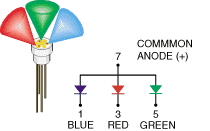The basic LED consists of a semiconductor diode chip mounted in the reflector cup of a lead frame that is connected to electrical (wire bond) wires, then encased in a solid epoxy lens. LEDs emit light when energy levels change in the semiconductor diode. This shift in energy generates photons, some of which are emitted as light. The specific wavelength of the light depends on the difference in energy levels as well as the type of semiconductor material used to form the LED chip. (see Figure G)
LEDs are color-controlled monochromatic, narrow bandwidth lux producing devices. Depending on how the LED chip is packaged determines the beam (narrow or wide) angle. Things that effect the beam angles are: shape of the reflector cup, size of the LED chip, epoxy lens shape, and the distance between the LED chip and the top of the epoxy lens.
LEDs are available in both visible and infrared wavelengths. Infrared LEDs reach wavelengths of 830 nanometers to 940 nm. Visible colors include red, yellow, orange, amber, green, blue/green, blue, and white. These fall into the spectral wavelength region of 400 nm to 700 nm. The colored light of an LED is determined exclusively by the semiconductor compound used to make the LED chip and independent of the epoxy lens color.
Molding different LED chips within a common housing creates (as an example, Red, Green and Blue chips, RGB LEDs) multicolor LEDs. Applying positive and negative voltages turn on each color. (see Figures H & H.1)
  
Figure H.1
|